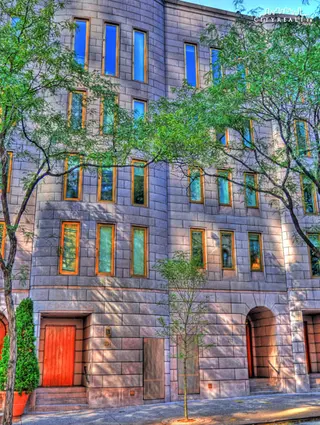 Carter Horsley
Carter HorsleyDec 23, 2011
Carter's Review
When they were built, this row of pink-granite-clad, bow-fronted townhouses was the first new row of townhouses to be built in Manhattan in decades.
They were erected by Sheldon Solow as part of his development of the adjacent black-glass residential skyscraper with rounded corners at 265 East 66th Street, which occupies the Second Avenue blockfront between 66th and 67th Streets.
One of the city's few sleekly modern apartment buildings, the large black-glass tower with rounded corners is striking and quite dramatic.
The well-proportioned, tower, which has no setbacks, was erected in 1978 and designed by Gruzen & Partners for Sheldon Solow, who also developed the sloping skyscraper at 9 West 57th Street and the tall apartment tower at One East River Place at 525 East 72nd Street.
Described by Elliot Willensky and Norval White as "tall, suave...the equivalent in architectural terms...of the gray flannel suit" in their fine book, "The A.I.A. Guide to New York City, Third Edition," (Harcourt Brace Jovanovich, 1988), the 46-story tower, which has 7 apartments a floor, significantly upgraded the Second Avenue corridor and reinforced the nearby emerging cluster of luxury residential towers along Third Avenue.
Willensky and White also noted in their book that "A welcome subtlety is its developer's decision not to employ an ostentatious name, rare for most recent luxury apartment towers."
In the four edition of the book, published by Three Rivers Press in 2000, the authors made the following comments about the townhouses:
"These 11 houses fail to capture any of the abundant spirit and charm of their linear antecedents, a boring line of richness in materials and architectural poverty."
The townhouses were designed by Eli Attia, whose other Manhattan projects include 101 Park Avenue. They have high ceilings and wood-burning fireplaces and sidewalk landscaping. The adjacent tower has a garage and a health club.
The houses share a building lot with a 46-story apartment house, 265 East 66th Street, which Mr. Solow finished in 1979. The distinctive 301-unit, gray-glass apartment building has an underground parking garage that occupies ground beneath the town houses.
In a November 12, 1989 article in The New York Times, Alan S. Oser wrote that the townhouses were started in 1983 but were only being completed in 1989.
"The first house was completed as a model, and the builder offered to finish the others and sell them to buyers for $4 million. But buyers demurred and the marketing effort ceased. The buildings sat untouched, hollow shells of floors and walls behind a pink-granite façade, until this year. Now all 10 are back in construction, with a triplex and a duplex in each building. They are on the market for rent at $12,500 or $13,000 a month for the triplexes, with 3,050 or 3,100 square feet of space, and $8,500 or $8,750 for the duplexes, with 2,100 or 2,150 square feet. Leasing began in September....The Solow town houses have links to the apartment house. They are tied in with its security system and are maintained and serviced by its staff. As for prices on a square-footage basis, they are renting for about $49 a square foot a year, topping even the average $42 that the builder is getting at East River Place, a 50-story, 415-unit building he has been renting out at 525 East 72d Street, on the East River, since January 1988."
"In the 70's," the article continued, "as the owner of a 40,000-square-foot site shaped like a backwards L - half along the west side of Second Avenue from 66th Street to 67th Street and the other half along 67th Street - Mr. Solow could have developed his site differently. He might have built a 35-story avenue tower and a 12- to 15-story midblock building, or a 51-story tower on Second Avenue, leaving the midblock area open as a private park. Instead, he decided to use 50,000 square feet of floor area available under the zoning law for 11 five-story town houses. Their 60-foot height is in scale with the midblock buildings behind them on East 66th Street, which Metropolitan Life Insurance Company owns as a protective buffer for its full-block Manhattan House rental development across the street. The low scale also would assure better views for residents of lower floors in the tower."
"The town houses," according to the article, "have 18-foot frontages, 30-foot rear gardens behind 70 feet of structure and façades that are alternately flat or curved. Inside, there are 17-foot-high living rooms for the triplex occupants, broad skylights over the duplexes, which are reached by private elevator, and a level of luxury in the fixtures and interior construction that comports with the rents."
The enclave is convenient to cross-town buses and a subway station is nearby at 67th Street and Lexington Avenue.
Although the townhouse row façades are not distinguished architecturally, they are impressive because of the fine materials and good detailing.

- Rental built in 1983
- 1 apartment currently for rent ($18.8K)
- Located in Lenox Hill
- 42 total apartments 42 total apartments
 6sqft delivers the latest on real estate, architecture, and design, straight from New York City.
6sqft delivers the latest on real estate, architecture, and design, straight from New York City.
